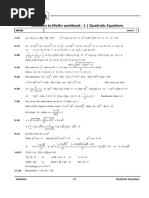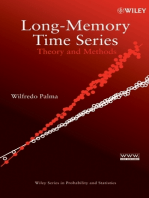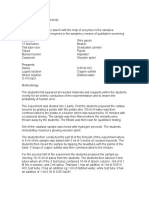5_PUC__Maths
5_PUC__Maths
Uploaded by
vchemashri47Copyright:
Available Formats
5_PUC__Maths
5_PUC__Maths
Uploaded by
vchemashri47Copyright
Available Formats
Share this document
Did you find this document useful?
Is this content inappropriate?
Copyright:
Available Formats
5_PUC__Maths
5_PUC__Maths
Uploaded by
vchemashri47Copyright:
Available Formats
II PUC : MATHEMATICS x 5 0 0
1
R1 R 3 2 6 1 35
DETERMINANTS 2
5 4 1
Applications of Determinants 70 x 5 6 4
a) To find the Area of the triangle: 10 x 5
Area of the triangle whose vertices are – 70
A x1 , y1 , B x 2 , y 2 , C x 3 , y3 x 5 7
10
x1 y1 1 x 5 7 (or) 7
1
x 2 y2 1 x 12, 2
2
x 3 y3 1 4. A le has its three sides equal to a, b & c. If
1 the coordinates of its vertices are A (x 1, y1),
x1y 2 x 2 y1 x 2 y 3 x 3y 2 x 3y1 x1y 3 2
2 x1 y1 2
b) The three points
A x1 , y1 , B x 2 , y2 , C x 3 , y3 B x 2 , y 2 and C x 3 , y3 , show that x 2 y 2 2
are collinear if and only if the area of the triangle is x 3 y3 2
zero. (a b c) (b c a) (c a b) (a b c).
1
x1 y1 1 So ln : Let be the area of the triangle ABC.
That is iff x2 y2 1 0
2 x1 y1 1
x3 y3 1 1
x 2 y 2 1 ..... ...(1)
Problems:- 2
x 3 y3 1
2
1. Using determinants, find the area of the x1 y1 2 x1 y1 1
2
triangle whose vertices are
L.H.S. x 2 y 2 2 2 x 2 y 2 1
1, 4 , 2, 3 , 5, 3
x y 1
Soln:- Area of the triangle = absolute value of x 3 y3 2 3 3
1 4 1 (2(2)) 2 16 2 [By (1)]
1
2 3 1 R.H.S = (a + b + c) (b + c - a)(c + a - b) (a + b-c)
2
5 3 1 = [2s (a + b + c - 2a) (a + b + c - 2b)
1 (a + b + c - 2c)]
1 3 3 4 2 5 1 6 15 (Using 2s = a + b + c)
2
1 = 2s (2s - 2a) (2s - 2b) (2s - 2c)
1 0 4 7 1 21
2 16s (s a)(s b)(s c)
1 1 49 2
0 28 21 49 sq.units 16 s(s a)(s b)(s c)
2 2 2
2. Using determinants, find the area of the 16 2 (By Area formula)
triangle whose vertices are -
L.H.S = R.H.S.
1, 1 , 2, 4 , 3, 5
and also find whether the points are collinear. Applications of simultaneous linear
Soln:- Area of the triangle = absolute value of equations
1 1 1 1. The sum of three numbers is 6. If we multiply
1
2 4 1 the third number by 2 and add the first number
2
3 5 1 to the result, we get 7. By adding second and
1 third numbers to three times the first number, we
1 4 5 1 2 3 1 10 12
2 get 12. Using matrices find the numbers.
1 1 Soln:- Let the three numbers be x, y and z
1 5 22 26
2 2 respectively, then,
13 sq.units x +y + z = 6.
Since the area of the triangle is not equal to Also, x + 2z = 7[given] and,
zero, the three given points are not collinear. 3x + y + z = 12
3. Find the value of x, if the area of the triangle is Thus, we obtain the following system of
35 sq.units with vertices simultaneous linear equations:
x, 4 , 2, 6 , 5, 4 x+y+z=6
x + 0y + 2z = 7
4 1 x
1 3x + y + z = 12
So ln : Absolute value of 2 6 1 35 The above system of equations can be written in
2
5 4 1 matrix form as
You might also like
- 《固体物理导论》 习题解答.charles Kittel.2004年第8版.introduction to Solid State Physics Solution ManualDocument61 pages《固体物理导论》 习题解答.charles Kittel.2004年第8版.introduction to Solid State Physics Solution ManualSane LeeNo ratings yet
- Kittel Charles - Introduction To Solid State Physics 8Th Edition - Solution ManualDocument60 pagesKittel Charles - Introduction To Solid State Physics 8Th Edition - Solution Manualnawarajbhandari86% (35)
- EJC H2 Math P1 With Solution PDFDocument23 pagesEJC H2 Math P1 With Solution PDFKipp SohNo ratings yet
- PDF Summary SuitsDocument14 pagesPDF Summary SuitsAshu KhandelwalNo ratings yet
- Advanced Circles Ex.2 (B)Document24 pagesAdvanced Circles Ex.2 (B)Ajay SinghNo ratings yet
- 2020 JC 2 H2 Math Consolidation Test II (Solutions)Document13 pages2020 JC 2 H2 Math Consolidation Test II (Solutions)Timothy HandokoNo ratings yet
- Conti, AOD, Ineq, Log, Function, Graph, MOD, Limits, Conti. Diffblty, AOD - DPPDocument16 pagesConti, AOD, Ineq, Log, Function, Graph, MOD, Limits, Conti. Diffblty, AOD - DPPShivam KumarNo ratings yet
- 2018 MYE Suggested SolutionsDocument21 pages2018 MYE Suggested Solutionsclarissay_1No ratings yet
- 2018-11-30_revision_for_tt2_answersDocument11 pages2018-11-30_revision_for_tt2_answersMehmet Derin OzserNo ratings yet
- Math 2021 p1 SolutionsDocument21 pagesMath 2021 p1 SolutionsVidushi KochharNo ratings yet
- 2019 SEM 2 Kelantan (Q & A) (2) 26 AugDocument12 pages2019 SEM 2 Kelantan (Q & A) (2) 26 AugGreen SlimeNo ratings yet
- Lecture Sheet 2Document18 pagesLecture Sheet 2SM Muntasir SarwarNo ratings yet
- Itf 5Document4 pagesItf 5Ayush GuptaNo ratings yet
- Mathematics 31 Calculus ReviewDocument12 pagesMathematics 31 Calculus ReviewMoizNo ratings yet
- Cramers Rule Chemical Application Problem PDFDocument8 pagesCramers Rule Chemical Application Problem PDFD AnuradhaNo ratings yet
- Cramers Rule Chemical Application ProblemDocument8 pagesCramers Rule Chemical Application ProblemD AnuradhaNo ratings yet
- DPP GB SirDocument3 pagesDPP GB SirDeepak N S0% (1)
- (Maa 3.9) More Trigonometric Functions - SolutionsDocument9 pages(Maa 3.9) More Trigonometric Functions - Solutionsabhinavjha405No ratings yet
- Brahmos Full Test MJG - SolutionDocument4 pagesBrahmos Full Test MJG - SolutionSRI HARININo ratings yet
- 1. JEE MAIN Maths Practice Assing - II (1)Document4 pages1. JEE MAIN Maths Practice Assing - II (1)sapnahari1234No ratings yet
- Application of DeterminantDocument4 pagesApplication of Determinantswapnendudutta2003No ratings yet
- 2010 CJC H2Math - P2-Prelim-solnDocument9 pages2010 CJC H2Math - P2-Prelim-solnHappy momoNo ratings yet
- ACE 11Ex1HY 2015 SolutionsDocument6 pagesACE 11Ex1HY 2015 SolutionsAsad ZamanNo ratings yet
- selfstudys_com_fileDocument23 pagesselfstudys_com_fileakarshkashyap4No ratings yet
- 2024 CBSE XII Maths (Compt. Exams) - by O.P. GUPTADocument23 pages2024 CBSE XII Maths (Compt. Exams) - by O.P. GUPTAedwardgeorge19212022No ratings yet
- It Is Given That - Solve The Equation - (5) : 1 Y2024 Am 4049 Prelim Paper 1 Solutions 1 (A)Document42 pagesIt Is Given That - Solve The Equation - (5) : 1 Y2024 Am 4049 Prelim Paper 1 Solutions 1 (A)typhoon2858No ratings yet
- Selfstudys Com FileDocument27 pagesSelfstudys Com FilepentelacharantejaNo ratings yet
- Limits Ass-3-4Document6 pagesLimits Ass-3-4sri sai surajNo ratings yet
- Promo08 Acjc H2 (Soln)Document8 pagesPromo08 Acjc H2 (Soln)toh tim lamNo ratings yet
- Test No. 01 Basic Maths 02-04-2024Document2 pagesTest No. 01 Basic Maths 02-04-2024Kushal KhadkeNo ratings yet
- Quadratic Equation Solution Miscellaneous Question BankDocument21 pagesQuadratic Equation Solution Miscellaneous Question BankSanchi GuptaNo ratings yet
- CPP 2 ItfDocument2 pagesCPP 2 Itfnakulsahu816No ratings yet
- ALPS 2209 Assignment SolutionsDocument17 pagesALPS 2209 Assignment SolutionsPBD ShortsNo ratings yet
- Math II-BA124 1st 2010-2011 - e ExamDocument2 pagesMath II-BA124 1st 2010-2011 - e ExamALI ELOUNYNo ratings yet
- ท - นกพ ธค 54 เฉลยโดย Aof InnoxentDocument10 pagesท - นกพ ธค 54 เฉลยโดย Aof Innoxentni'New BaobaoNo ratings yet
- IIT (JEE) - 2012 Paper - 1 SolutionsDocument9 pagesIIT (JEE) - 2012 Paper - 1 SolutionsabhinayvongurNo ratings yet
- Factoring and Algebra - A Selection of Classic Mathematical Articles Containing Examples and Exercises on the Subject of Algebra (Mathematics Series)From EverandFactoring and Algebra - A Selection of Classic Mathematical Articles Containing Examples and Exercises on the Subject of Algebra (Mathematics Series)No ratings yet
- Trigonometric Ratios to Transformations (Trigonometry) Mathematics E-Book For Public ExamsFrom EverandTrigonometric Ratios to Transformations (Trigonometry) Mathematics E-Book For Public ExamsRating: 5 out of 5 stars5/5 (1)
- Analytic Geometry: Graphic Solutions Using Matlab LanguageFrom EverandAnalytic Geometry: Graphic Solutions Using Matlab LanguageNo ratings yet
- De Moiver's Theorem (Trigonometry) Mathematics Question BankFrom EverandDe Moiver's Theorem (Trigonometry) Mathematics Question BankNo ratings yet
- Transformation of Axes (Geometry) Mathematics Question BankFrom EverandTransformation of Axes (Geometry) Mathematics Question BankRating: 3 out of 5 stars3/5 (1)
- On the Tangent Space to the Space of Algebraic Cycles on a Smooth Algebraic VarietyFrom EverandOn the Tangent Space to the Space of Algebraic Cycles on a Smooth Algebraic VarietyNo ratings yet
- 10+2 Level Mathematics For All Exams GMAT, GRE, CAT, SAT, ACT, IIT JEE, WBJEE, ISI, CMI, RMO, INMO, KVPY Etc.From Everand10+2 Level Mathematics For All Exams GMAT, GRE, CAT, SAT, ACT, IIT JEE, WBJEE, ISI, CMI, RMO, INMO, KVPY Etc.No ratings yet
- A-level Maths Revision: Cheeky Revision ShortcutsFrom EverandA-level Maths Revision: Cheeky Revision ShortcutsRating: 3.5 out of 5 stars3.5/5 (8)
- Student Solutions Manual to Accompany Economic Dynamics in Discrete Time, second editionFrom EverandStudent Solutions Manual to Accompany Economic Dynamics in Discrete Time, second editionRating: 4.5 out of 5 stars4.5/5 (2)
- Application of Derivatives Tangents and Normals (Calculus) Mathematics E-Book For Public ExamsFrom EverandApplication of Derivatives Tangents and Normals (Calculus) Mathematics E-Book For Public ExamsRating: 5 out of 5 stars5/5 (1)
- Mathematics 1St First Order Linear Differential Equations 2Nd Second Order Linear Differential Equations Laplace Fourier Bessel MathematicsFrom EverandMathematics 1St First Order Linear Differential Equations 2Nd Second Order Linear Differential Equations Laplace Fourier Bessel MathematicsNo ratings yet
- Geometry and Locus (Geometry) Mathematics Question BankFrom EverandGeometry and Locus (Geometry) Mathematics Question BankNo ratings yet
- Comprehensive Dental Notes For MBBS - LohaniDocument68 pagesComprehensive Dental Notes For MBBS - LohaniPratik100% (2)
- Heisenberg Model - 230330 - 172244Document3 pagesHeisenberg Model - 230330 - 1722449th P/C completedNo ratings yet
- Learning Module Blended Flexible Learning: Organization and Management (ORMA 321)Document14 pagesLearning Module Blended Flexible Learning: Organization and Management (ORMA 321)MARITONI MEDALLANo ratings yet
- Neural Networks PDFDocument1 pageNeural Networks PDFSunayana NaikNo ratings yet
- HDB-Supervision Guide For Electrical Engineering WorksDocument24 pagesHDB-Supervision Guide For Electrical Engineering WorksZhu Qi Wang50% (2)
- MINH HỌA SỐ 5Document13 pagesMINH HỌA SỐ 5Doãn Yến100% (1)
- Rezultat Test de Culoare Reghin: by Erika GinnisDocument8 pagesRezultat Test de Culoare Reghin: by Erika Ginnismicuadria0% (1)
- Savage 2017Document47 pagesSavage 2017the_fralics9349No ratings yet
- Džejms Džojs Portret Umetnika U Mladosti PDFDocument57 pagesDžejms Džojs Portret Umetnika U Mladosti PDFMilicaMilovic0% (1)
- Waterproofing Underground Concrete Structures.: Biggins, TimDocument233 pagesWaterproofing Underground Concrete Structures.: Biggins, TimTharani ThangaNo ratings yet
- MATH G8_Q3_M4 (32pages)Document32 pagesMATH G8_Q3_M4 (32pages)mariejoy0430No ratings yet
- 15812Document1 page15812Ahmed ElsayedNo ratings yet
- Review of Related Literature and StudiesDocument15 pagesReview of Related Literature and StudiesJohn Lester M. Dela CruzNo ratings yet
- 7 2Document4 pages7 2Gerardo E. Lopez MoralesNo ratings yet
- Consequences of The Dzyaloshinskii-Moriya InteractionDocument33 pagesConsequences of The Dzyaloshinskii-Moriya InteractionjordypigaianeNo ratings yet
- Shunt Capacitor Bank Fundamentals and ProtectionDocument2 pagesShunt Capacitor Bank Fundamentals and ProtectionaryanNo ratings yet
- 推广服务协议 HUANG HAPPY FEET INCDocument13 pages推广服务协议 HUANG HAPPY FEET INCazulina LIUNo ratings yet
- #6 LogicDocument15 pages#6 Logicregina.rmsNo ratings yet
- Kewirausahaan 3: Business StrategyDocument11 pagesKewirausahaan 3: Business StrategyPratama RafiNo ratings yet
- 6 - L-9 (DK) (Pe) ( (Ee) Nptel)Document1 page6 - L-9 (DK) (Pe) ( (Ee) Nptel)SereneNo ratings yet
- UB - Assignment - 1Document2 pagesUB - Assignment - 1Ngô Ánh HuyềnNo ratings yet
- SDO Camarines Norte: Facilitating Dreams, Valuing AspirationsDocument7 pagesSDO Camarines Norte: Facilitating Dreams, Valuing Aspirationsshuckss taloNo ratings yet
- Pyrantel Paste Detail SheetDocument2 pagesPyrantel Paste Detail SheetmariaNo ratings yet
- Especificaciones DS-2PT3326IZ-DE3Document4 pagesEspecificaciones DS-2PT3326IZ-DE3jrdp83No ratings yet
- Zimbra PST Migration Wizard: User's GuideDocument6 pagesZimbra PST Migration Wizard: User's GuideKaryn AntunezNo ratings yet
- Free Rider & Rocker Instruction ManualDocument1 pageFree Rider & Rocker Instruction ManualBen SzapiroNo ratings yet
- Hydrolysis of StarchDocument5 pagesHydrolysis of StarchJayrone James FuerteNo ratings yet
- Module 04 - Part1 AssignmentDocument10 pagesModule 04 - Part1 Assignmentsuresh avadutha75% (4)
- The Difference Between A Cover Letter and A Letter of Application Are What They Are Used ForDocument6 pagesThe Difference Between A Cover Letter and A Letter of Application Are What They Are Used Forshah md musleminNo ratings yet

























































































